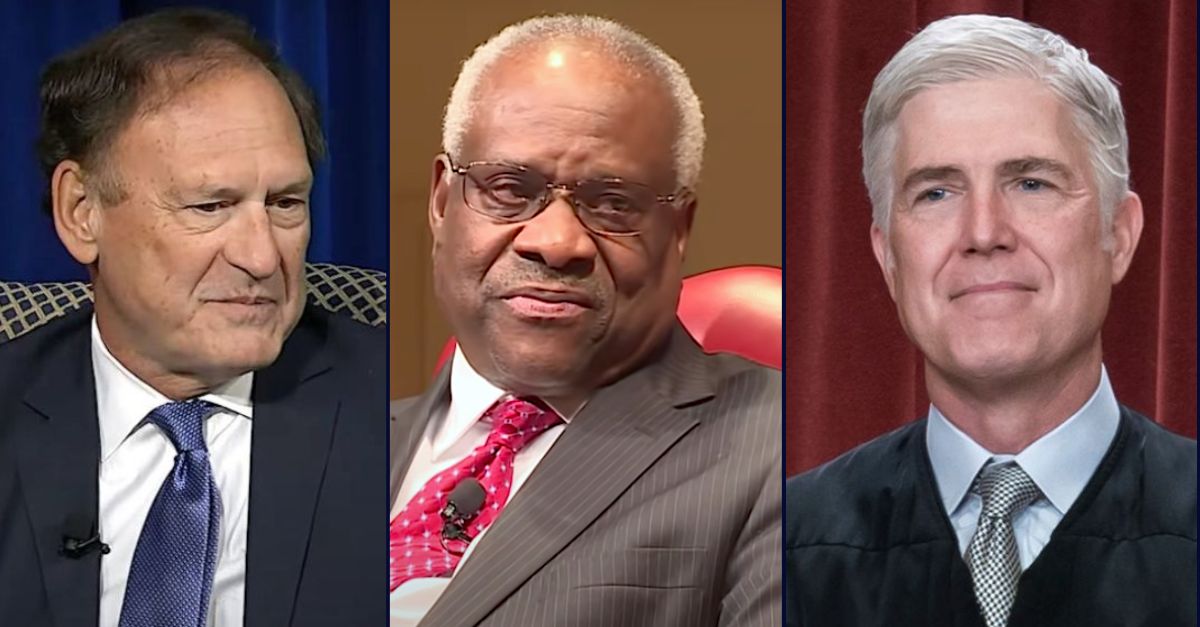
Left: Samuel Alito (YouTube/The Heritage Foundation); Center: Clarence Thomas (YouTube/Library of Congress); Right: Neil Gorsuch (Erin Schaff-Pool/Getty Images)
The Supreme Court refused Monday to hear a race-based challenge to an admissions policy used for one year by three prestigious Boston public schools — but three conservative justices weren’t entirely on board.
Boston Latin School — the nation’s oldest public school, founded in 1635 — and two other schools in Boston that are considered selective with their admissions, instituted a temporary plan during the COVID-19 pandemic that based admissions on student grade-point averages, ZIP codes, and family income, rather than on standardized test scores. The plan sought to rectify racial inequities in admissions by setting up admissions quotas by ZIP code, then ranking students based on grades and family income. The schools used this plan only for the 2021-22 school year, because administering standardized tests was not feasible during the pandemic; the next year, the schools returned to a plan that relied on grade-point averages.
A coalition of parents and students sued, raising state and federal Equal Protection Clause challenges on the basis that the plan had a disparate impact on Asian and white students.
The United States Court of Appeals for the First Circuit sided with the schools and held that the plaintiffs failed to show any relevant disparate impact on white and Asian students, given that the two groups were overrepresented, and that there had been no discriminatory intent in adopting the plan. The court ruled that evidence submitted by the coalition “falls woefully short of the mark” in proving that the schools’ plan made it disproportionately hard for white and Asian students to gain acceptance, and called the coalition’s statistical analysis a “sleight of hand.”
The First Circuit’s ruling came six months after the Supreme Court handed down a 6-3 ruling eradicating affirmative action admissions policies in universities.
Justices Neil Gorsuch and Samuel Alito penned statements on the Court’s denial of certiorari, the latter of which was joined by Justice Clarence Thomas.
Gorsuch noted that the challenged policy was replaced after one year and that the new policy is not part of the lawsuit. However, Gorsuch also wrote that Alito’s statement “expresses today a number of significant concerns about the First Circuit’s analysis,” which the Court “would do well to consider” in the future.
Alito dissented from the Court’s denial of certiorari in a statement joined by Thomas. In it, Alito said the committee that adopted the admissions policy was aiming to “put race front and center.” Alito noted that, “The meeting kicked off with a lengthy statement from ‘anti-racist activist’ Dr. Ibram X. Kendi, who specifically said the policy would “close racial and economic gaps,” and that the committee chairperson was caught on the un-muted Zoom meeting mocking the Asian-sounding names of three citizens and amusing others on the committee by texting about the names.
“The new policy worked as intended,” concluded Alito. “Between the 2020–2021 and 2021–2022 school years, black students increased from 14% to 23%; Latino students increased from 21% to 23%; white students decreased from 40% to 31%; and Asian students decreased from 21% to 18%.”
Alito said there was “overwhelming direct evidence of intentional discrimination,” and that the analysis used by the lower courts was “indefensible twice over.”
Alito called the schools’ policy “racial balancing by another name” and pronounced it “undoubtedly unconstitutional,” as the justice slammed the schools for working to decrease the number of white and Asian students in the name of “racial equity.” Alito said that this is the second time that the justices have, “refused to correct a glaring constitutional error that threatens to perpetuate race-based affirmative action in defiance of Students for Fair Admissions.”
“I would reject root and branch this dangerously distorted view of disparate impact,” snapped Alito in conclusion.
You can read the full statement here.







